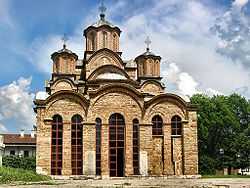Gračanica, Kosovo
| Gračanica | |
|---|---|
| Town and municipality | |
|
| |
 Gračanica Location in Kosovo | |
| Coordinates: 42°36′N 21°12′E / 42.600°N 21.200°ECoordinates: 42°36′N 21°12′E / 42.600°N 21.200°E | |
| Country | Kosovo |
| District | District of Pristina |
| Established | 29 December 2009[1] |
| Government | |
| • Mayor | Vladeta Kostić |
| Area | |
| • Total | 131.25 km2 (50.68 sq mi) |
| Population (2011) | |
| • Total | 11,006 |
| • Density | 84/km2 (220/sq mi) |
| • Town | 4,500 |
| Time zone | CET (UTC+1) |
| Website | |
Gračanica (In Serbian; Грачаница, pronounced [ɡratʃǎnitsa]) or Graçanicë (In Albanian) is a town and municipality in central Kosovo.[lower-alpha 1] It is a Serb enclave centered on the Gračanica monastery, ten kilometers east of Pristina. The 1999 Kosovo War and its aftermath transformed Gračanica from a sleepy village into an administrative center serving the needs of the 75,000 Kosovo Serbs living south of the Ibar River. International banks, internet cafes, and outlets of Serbian governmental institutions are located amidst traditional farmhouses, giving Gračanica the feel of a semi-urban center dislocated into a rural community.
History
The village was mentioned for the first time in 1303, in a letter of Pope Benedict IX (as Grazaniza). It was mentioned in King Stefan Milutin's Gračanica charter regarding the founding of the Gračanica monastery (1321).
In June 6, 2000, a grenade was thrown at a crowd of ethnic Serbs waiting for a bus in the town square, injuring three people, which was followed by some civil unrest.[2] In the aftermath of the 2004 unrest in Kosovo, a Serb teenager was killed in a drive-by shooting on June 5, 2004.[3][4]
Municipality
The municipality of Gračanica was established in 2008 by the Government of the Republic of Kosovo, out of parts of the municipalities of Lipljan, Kosovo Polje and Pristina.[5] Although the new municipality is primarily inhabited by Serbs, this move is not recognized by the Serbian government which does not recognize the Republic of Kosovo and its administrative changes.[6] According to the administration of the Republic of Kosovo, the name of the municipality in Albanian is Graçanicë (an Albanian transliteration).
The first municipal elections were held on 15 November 2009.[7] The government of Serbia asked Serbs not to participate in the elections[7] which it does not recognize, but many of them did. Serb Bojan Stojanović was elected Mayor.[8] Town of Gračanica is also temporary seat of the administration of Serbia-recognized City of Pristina. The Serbia-sponsored local elections were held on 11 May 2008. Those elections were boycotted by the Albanians who consider Kosovo independent from Serbia, so only Serbs participated. Radovan Ničić was elected Mayor.
Population
The village of Gračanica is said to contain approximately 11,006 inhabitants, many of whom are Serb refugees driven out of Pristina.[9] Differing estimates exist for the enclave as a whole, ranging from 13,000[10] to 11,006 inhabitants in the 15 villages that make up the enclave,[11] and down from 120,000 in 1999.[11] The enclave has a roughly ten-kilometer radius in which Serbs enjoy freedom of movement and attempt to organize a meaningful life for themselves.[9]
Ethnic composition of the municipality, as of 2010:[12]
- Serbs – 85.7%
- Albanians – 3.7%
- Others – 10.6% (Roma, Ashkali, Egyptians)
Infrastructure and position
Gračanica has been a Serb enclave since the end of the 1999 Kosovo War, and is the largest and most secure Serbian enclave in central Kosovo. It runs along the Skopje-Pristina road, and unites several neighboring Serbian villages. The enclave, which contains rich farmland and is strategically located in the center of Kosovo, on major roads and near Pristina, has been seen as a potential threat by some Albanian nationalists, who view it as "a den of Serbian intrigue".[13]
Gračanica has an elementary school, several small stores, an open-air market and a police station that employs ethnic Albanians and international police officers, who notably do not speak the Serbian language. The health care center is located in the central part of the town, next to the UNMIK headquarters. An elementary school was reconstructed after the 1999 war.[13] In December 2008, the Serbian government built a €90,000 post office in Gračanica and promised further investments.
Settlements in the municipality
|
|
Annotations
- ↑ Kosovo is the subject of a territorial dispute between the Republic of Serbia and the Republic of Kosovo. The latter declared independence on 17 February 2008, but Serbia continues to claim it as part of its own sovereign territory. Kosovo's independence has been recognised by 108 out of 193 United Nations member states.
References
- ↑ "(Serbian) Opština Gračanica / Komuna e Gracanices".
- ↑ http://www.ce-review.org/00/23/kosovonews23.html
- ↑ http://www.b92.net/info/vesti/index.php?yyyy=2004&mm=06&dd=05&nav_id=142643
- ↑ http://news.bbc.co.uk/2/hi/europe/3780165.stm
- ↑ Zakon br. o3/L – 041 O ADMINISTRATIVNIM GRANICAMA OPŠTINA (Law on administrative boundaries of municipalities), 20 February 2008 (Serbian)
- ↑ Law on Territorial Organization and Local Self-Government, Parliament of Serbia (Serbian)
- ↑ 7.0 7.1 Nova Srpska Politička Misao: Грачаница: Срби да бојкотују изборе које организују косовске институције, 29 October 2009 (Serbian)
- ↑ B92: Gračanica: Protest zbog izbora, 27 November 2009 (Serbian)
- ↑ 9.0 9.1 B92 – Many B92 looks at life in K. Serb enclaves, Oct. 13, 2008
- ↑ B92 – Russian aid distributed to Kosovo Serbs, 7 May 2008
- ↑ 11.0 11.1 UmnikOnline – Many Kosovo Serbs see elections as last hope for a better life, Nov. 13, 2001
- ↑ http://www.opstina-gracanica.com/index.php?option=com_content&view=article&id=137&Itemid=56
- ↑ 13.0 13.1 Balkan Analysis – Kosovo: The Deadly Game Continues, 6/7/2004
External links
| ||||||||||||||||||||||||||||||||

